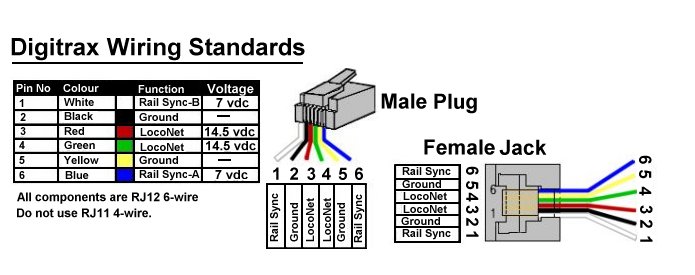Standalone LocoNet
Summary: A Standalone LocoNet is a throttle network bus without a Command Station. As it has no command station, it cannot influence the DCC signal created by a command station, nor can it control locomotives on the track.
Applications
Since a standalone LocoNet bus does not have a command station, it is possible to use LocoNet components with a Digital Command Control system other than one from Digitrax. It also allows usage of LocoNet devices on a layout which does not have DCC installed.
Another reason is to isolate some LocoNet devices from LocoNet throttle activity. Digitrax users may also want to avoid network issues caused by hardware limitations of the command station.
Some users may also want to use JMRI to control the layout using two LocoNet connections, one for track/throttle operations, and another for detection and signalling purposes.
There are LocoNet applications which do not require all the capabilities of a command station to control and operate LocoNet devices, for which a simple standalone LocoNet would suffice.
If you do create a standalone LocoNet in addition to an existing Loconet, ensure the wires are identified to indicate the difference between the two networks.
Electrical Requirements
Termination
LocoNet termination is required for a standalone LocoNet to function. Some LocoNet devices can function as the master to provide this. If not, provisions must be made to terminate the LocoNet signal wires.
There can only be one master on the network.
Rail Sync
Rail Sync may be required to power some devices.
This can be provided using a small 12Vdc 500mA power supply. The positive terminal supplies the Rail Sync on pins 1 and six (White and Blue wires) while the Black and Yellow ground wires are connected to the negative terminal.
This is only used when a low power DCC track signal will not be present on the network.
Some devices require the Rail Sync as provided by a command station to function, such as the BDL series of occupancy detectors. These may not work on a standalone LocoNet bus.
Rail Sync from a Digitrax Command Station
It is possible to supply rail sync to a standalone LocoNet using a command station. This is done by connecting the Rail Sync and ground wires to their equivalents on the standalone LocoNet. This can be done using a cable or a terminal block with RJ jacks.
Rail Sync from an NCE Command Station
A simple resistor network can be used to provide the Rail Sync signals using NCE's Cab Bus. See the JMRI Standalone LocoNet page for more details.
Important Note Regarding Rail Sync
If supplying power to the Rail Sync lines, this power supply must exclusively supply power to devices on the standalone LocoNet. If alternate current paths exist, damage to devices on the network, wiring or power supply could occur. The same rule applies to LocoNet terminations.
If the Rail Sync connections are actively used for signalling purposes by a device on the network, do not power the Rail Sync lines.
If using a command station to provide Rail Sync, the two networks must be isolated to avoid an alternate path for currents to flow.
Further Reading
- The JMRI standalone LocoNet page has a lot of information and diagrams.
- Stand Alone LocoNet Wiring at RR-Cirkits
- Using Digitrax Devices on a Non Digitrax DCC Controlled Layout
- Additional information can be found using a search engine.
